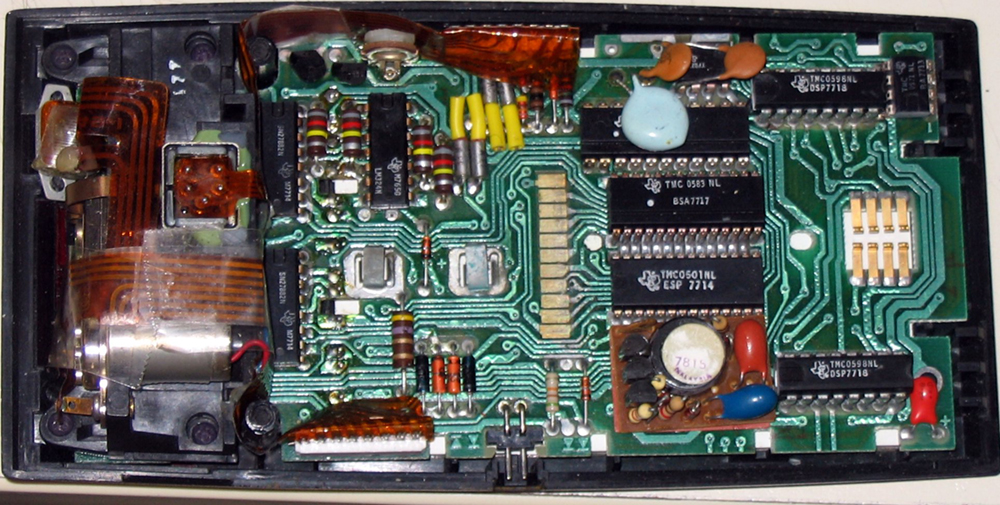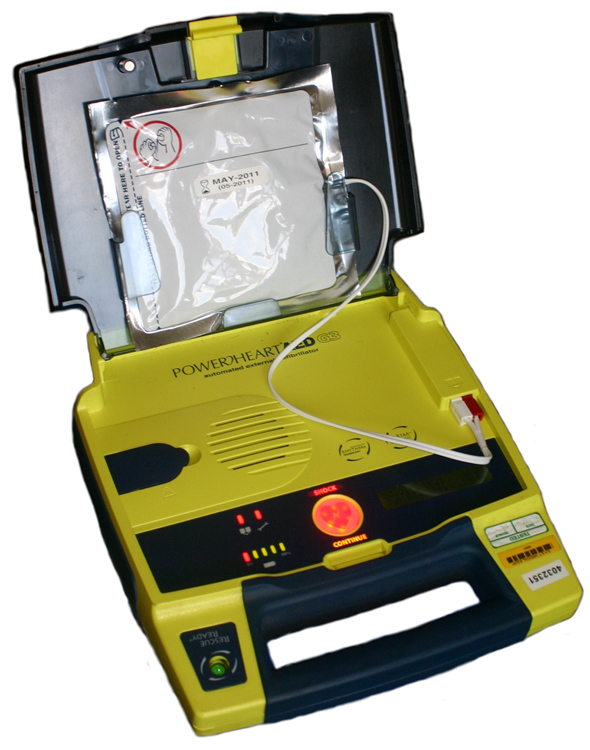Chapter 19 Electric Potential and Electric Field
19.7 Energy Stored in Capacitors
Summary
- List some uses of capacitors.
- Express in equation form the energy stored in a capacitor.
- Explain the function of a defibrillator.
Most of us have seen dramatizations in which medical personnel use a defibrillator to pass an electric current through a patient’s heart to get it to beat normally. (Review Figure 1.) Often realistic in detail, the person applying the shock directs another person to “make it 400 joules this time.” The energy delivered by the defibrillator is stored in a capacitor and can be adjusted to fit the situation. SI units of joules are often employed. Less dramatic is the use of capacitors in microelectronics, such as certain handheld calculators, to supply energy when batteries are charged. (See Figure 1.) Capacitors are also used to supply energy for flash lamps on cameras.

Energy stored in a capacitor is electrical potential energy, and it is thus related to the charge ![]() and voltage
and voltage ![]() on the capacitor. We must be careful when applying the equation for electrical potential energy
on the capacitor. We must be careful when applying the equation for electrical potential energy ![]() to a capacitor. Remember that
to a capacitor. Remember that ![]() is the potential energy of a charge
is the potential energy of a charge ![]() going through a voltage
going through a voltage ![]() . But the capacitor starts with zero voltage and gradually comes up to its full voltage as it is charged. The first charge placed on a capacitor experiences a change in voltage
. But the capacitor starts with zero voltage and gradually comes up to its full voltage as it is charged. The first charge placed on a capacitor experiences a change in voltage ![]() , since the capacitor has zero voltage when uncharged. The final charge placed on a capacitor experiences
, since the capacitor has zero voltage when uncharged. The final charge placed on a capacitor experiences ![]() , since the capacitor now has its full voltage
, since the capacitor now has its full voltage ![]() on it. The average voltage on the capacitor during the charging process is
on it. The average voltage on the capacitor during the charging process is ![]() , and so the average voltage experienced by the full charge
, and so the average voltage experienced by the full charge ![]() is
is ![]() . Thus the energy stored in a capacitor,
. Thus the energy stored in a capacitor, ![]() , is
, is
where ![]() is the charge on a capacitor with a voltage
is the charge on a capacitor with a voltage ![]() applied. (Note that the energy is not
applied. (Note that the energy is not ![]() , but
, but ![]() .) Charge and voltage are related to the capacitance
.) Charge and voltage are related to the capacitance ![]() of a capacitor by
of a capacitor by ![]() , and so the expression for
, and so the expression for ![]() can be algebraically manipulated into three equivalent expressions:
can be algebraically manipulated into three equivalent expressions:
where ![]() is the charge and
is the charge and ![]() the voltage on a capacitor
the voltage on a capacitor ![]() . The energy is in joules for a charge in coulombs, voltage in volts, and capacitance in farads.
. The energy is in joules for a charge in coulombs, voltage in volts, and capacitance in farads.
Energy Stored in Capacitors
The energy stored in a capacitor can be expressed in three ways:
where ![]() is the charge,
is the charge, ![]() is the voltage, and
is the voltage, and ![]() is the capacitance of the capacitor. The energy is in joules for a charge in coulombs, voltage in volts, and capacitance in farads.
is the capacitance of the capacitor. The energy is in joules for a charge in coulombs, voltage in volts, and capacitance in farads.
In a defibrillator, the delivery of a large charge in a short burst to a set of paddles across a person’s chest can be a lifesaver. The person’s heart attack might have arisen from the onset of fast, irregular beating of the heart—cardiac or ventricular fibrillation. The application of a large shock of electrical energy can terminate the arrhythmia and allow the body’s pacemaker to resume normal patterns. Today it is common for ambulances to carry a defibrillator, which also uses an electrocardiogram to analyze the patient’s heartbeat pattern. Automated external defibrillators (AED) are found in many public places (Figure 2). These are designed to be used by lay persons. The device automatically diagnoses the patient’s heart condition and then applies the shock with appropriate energy and waveform. CPR is recommended in many cases before use of an AED.

Example 1: Capacitance in a Heart Defibrillator
A heart defibrillator delivers ![]() of energy by discharging a capacitor initially at
of energy by discharging a capacitor initially at ![]() . What is its capacitance?
. What is its capacitance?
Strategy
We are given ![]() and
and ![]() , and we are asked to find the capacitance
, and we are asked to find the capacitance ![]() . Of the three expressions in the equation for E
. Of the three expressions in the equation for E![]() , the most convenient relationship is
, the most convenient relationship is
Solution
Solving this expression for ![]() and entering the given values yields
and entering the given values yields
![Rendered by QuickLaTeX.com $\begin{array}{r @{{}={}} l} \boldsymbol{C} & \boldsymbol{\frac{2E_{\textbf{cap}}}{V^2} = \frac{2(4.00 \times 10^2 \;\textbf{J})}{(1.00 \times 10^4 \;\textbf{V})^2} = 8.00 \times 10^{-6} \;\textbf{F}} \\[1em] & \boldsymbol{8.00 \;\mu \textbf{F}}. \end{array}$](https://pressbooks.online.ucf.edu/app/uploads/quicklatex/quicklatex.com-5ad2c7b16e94bef4e9a43ff780150861_l3.png)
Discussion
This is a fairly large, but manageable, capacitance at ![]() .
.
Section Summary
- Capacitors are used in a variety of devices, including defibrillators, microelectronics such as calculators, and flash lamps, to supply energy.
- The energy stored in a capacitor can be expressed in three ways:






where
 is the charge,
is the charge,  is the voltage, and
is the voltage, and  is the capacitance of the capacitor. The energy is in joules when the charge is in coulombs, voltage is in volts, and capacitance is in farads.
is the capacitance of the capacitor. The energy is in joules when the charge is in coulombs, voltage is in volts, and capacitance is in farads.
Conceptual Questions
1: How does the energy contained in a charged capacitor change when a dielectric is inserted, assuming the capacitor is isolated and its charge is constant? Does this imply that work was done?
2: What happens to the energy stored in a capacitor connected to a battery when a dielectric is inserted? Was work done in the process?
Problems & Exercises
1: (a) What is the energy stored in the ![]() capacitor of a heart defibrillator charged to
capacitor of a heart defibrillator charged to ![]() ? (b) Find the amount of stored charge.
? (b) Find the amount of stored charge.
2: In open heart surgery, a much smaller amount of energy will defibrillate the heart. (a) What voltage is applied to the ![]() capacitor of a heart defibrillator that stores 40.0 J of energy? (b) Find the amount of stored charge.
capacitor of a heart defibrillator that stores 40.0 J of energy? (b) Find the amount of stored charge.
3: A ![]() capacitor is used in conjunction with a motor. How much energy is stored in it when 119 V is applied?
capacitor is used in conjunction with a motor. How much energy is stored in it when 119 V is applied?
4: Suppose you have a 9.00 V battery, a ![]() capacitor, and a
capacitor, and a ![]() capacitor. (a) Find the charge and energy stored if the capacitors are connected to the battery in series. (b) Do the same for a parallel connection.
capacitor. (a) Find the charge and energy stored if the capacitors are connected to the battery in series. (b) Do the same for a parallel connection.
5: A nervous physicist worries that the two metal shelves of his wood frame bookcase might obtain a high voltage if charged by static electricity, perhaps produced by friction. (a) What is the capacitance of the empty shelves if they have area ![]() and are 0.200 m apart? (b) What is the voltage between them if opposite charges of magnitude 2.00 nC are placed on them? (c) To show that this voltage poses a small hazard, calculate the energy stored.
and are 0.200 m apart? (b) What is the voltage between them if opposite charges of magnitude 2.00 nC are placed on them? (c) To show that this voltage poses a small hazard, calculate the energy stored.
6: Show that for a given dielectric material the maximum energy a parallel plate capacitor can store is directly proportional to the volume of dielectric (![]() ). Note that the applied voltage is limited by the dielectric strength.
). Note that the applied voltage is limited by the dielectric strength.
7: Construct Your Own Problem
Consider a heart defibrillator similar to that discussed in Example 1. Construct a problem in which you examine the charge stored in the capacitor of a defibrillator as a function of stored energy. Among the things to be considered are the applied voltage and whether it should vary with energy to be delivered, the range of energies involved, and the capacitance of the defibrillator. You may also wish to consider the much smaller energy needed for defibrillation during open-heart surgery as a variation on this problem.
8: Unreasonable Results
(a) On a particular day, it takes ![]() of electric energy to start a truck’s engine. Calculate the capacitance of a capacitor that could store that amount of energy at 12.0 V. (b) What is unreasonable about this result? (c) Which assumptions are responsible?
of electric energy to start a truck’s engine. Calculate the capacitance of a capacitor that could store that amount of energy at 12.0 V. (b) What is unreasonable about this result? (c) Which assumptions are responsible?
Glossary
- defibrillator
- a machine used to provide an electrical shock to a heart attack victim’s heart in order to restore the heart’s normal rhythmic pattern
Solutions
Problems & Exercises
1: (a) 405 J
(b) 90.0 mC
2: (a) 3.16 kV
(b) 25.3 mC
4: (a) ![]() ,
, ![]()
(b) ![]() ,
, ![]()
5: (a) ![]()
(b) 452 V
(c) ![]()
8: (a) 133 F
(b) Such a capacitor would be too large to carry with a truck. The size of the capacitor would be enormous.
(c) It is unreasonable to assume that a capacitor can store the amount of energy needed.

